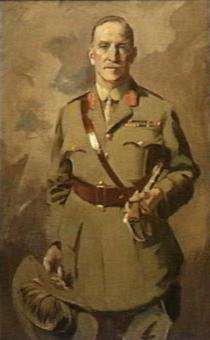James Peter Quinn

James Peter Quinn (4 December 1869 – 18 February 1951) was an Australian portrait painter born in Melbourne[1]
He studied part-time under Frederick McCubbin 1887–1999, at the Melbourne National Gallery School under George Folingsby and Bernard Hall 1889–1893, then in Paris at the Académie Julian and the École des Beaux-Arts from 1893–1901 under Jean Paul Laurens aided by a National Gallery of Victoria travelling scholarship. He spent time painting at the Etaples art colony in northern France, alongside other Australians including Rupert Bunny and Hilda Rix Nicholas.[2]
By 1904 he was a highly successful portrait painter and exhibited with the Royal Academy of Arts. His Mère et Fils (of his wife and son), was awarded an honourable mention at the Old Salon, Paris, in 1912. He was commissioned to paint Joseph Chamberlain, the Duchess of York and the Duke of Windsor.
He was accredited official war artist for the First AIF during World War I, painting prominent officers in France (causing considerable friction with authorities and fellow artists[3]).
In 1919 in London, Quinn painted General Sir John Monash, Commander in Chief of the Australian Corps. Monash, credited as the most resourceful and innovative General of WW1, planned and carried out with his 5 Australian Divisions, and the Canadian Corps on their right flank, the significant victory at the Battle of Amiens, 8 Aug 1918 - 0808 - which brought about the earlier than expected end to WW1. Quinn's portrait hung over the Monash-Bennett family mantel until recently loaned permanently to the Australian National Portrait Gallery,[4] Canberra. This portrait, the family favourite, was the model for the Monash Medal[5] awarded each year to an Outstanding Australian for her/his contribution in Leadership, Integrity and Service to the Australian community and beyond.
Then from 1919 Quinn worked with Canadian War Records, only returning to Australia in December 1935 after the death of son René. He rejoined the highly conservative Victorian Artists Society, and was even president for a year, but his openness to modern art made him no friends, and was the basis of a public confrontation with Prime Minister Robert Menzies.[1]
In 1937, Quinn was elected president of the Victorian Art School, a position he held until his death in 1951, and taught at the National Gallery of Victoria Art School. A commemorative exhibition at the Victorian Centre of the Arts in 1980 enhanced his posthumous reputation.[3]
Selected works
A portrait of sculptor Harold Parker hangs in the National Library of Australia.
The collection of the Australian War Memorial, Canberra includes a number of his war portraits, e.g.,
- Sir Harry Chauvel, 1919
- Lieutenant-General Sir John Monash GCMG KCB, 1918
- William Riddell Birdwood (Baron Birdwood)
- Queen Elizabeth (later known as the Queen Mother), 1936[3]
Gallery
 My friend Harold Parker, c. 1907. Oil on canvas on board, 35.5 x 31 cm., collection of the National Library of Australia
My friend Harold Parker, c. 1907. Oil on canvas on board, 35.5 x 31 cm., collection of the National Library of Australia Lieutenant General Sir Henry Chauvel, 1919. Oil on canvas, 121.2 x 75.2 cm., collection of the Australian War Memorial
Lieutenant General Sir Henry Chauvel, 1919. Oil on canvas, 121.2 x 75.2 cm., collection of the Australian War Memorial
References
Notes
- 1 2 Fraser, Alison (1951-02-18). "Biography - James Peter Quinn - Australian Dictionary of Biography". Adbonline.anu.edu.au. Retrieved 2014-06-08.
- ↑ Eagle & Jones 1994, p. 120.
- 1 2 3 "Artist Profiles | Australian War Memorial". Awm.gov.au. Retrieved 2014-06-08.
- ↑ "National Portrait Gallery">http://www.portrait.gov.au
- ↑ "Monash Medal" http://www.rotaryclubofmelbourne.org.au/html/s02_article/default.asp?nav_top_id=53&nav_cat_id=358
Bibliography
- Art in Australia no.8 1921
- Eagle, Mary; John Jones (1994). A Story of Australian Painting. Chippendale, NSW: Macmillan Australia. ISBN 0-7329-0778-0. Cite uses deprecated parameter
|coauthors=(help) - McCullough, Alan (1968). Encyclopedia of Australian Art. London: Hutchinson. ISBN 0090814207.
External links
| Wikimedia Commons has media related to James Peter Quinn. |